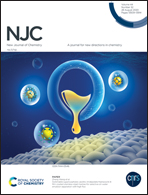Novel BODIPY-subphthalocyanine dyads with reasonable photodynamic therapy behaviours†
Abstract
In this study, a set of bio-compatible and NIR emissive BODIPY-subphthalocyanine dyads (SP–DBD1–3) that contain amphiphilic triethyleneglycol units supporting partial water solubility and red absorbing BODIPY monomers (DBD1–3) were prepared. The photophysical and photochemical activities of these monomers, including fluorescence behaviors, singlet oxygen production, absorption, and emission profiles were investigated. The effect of the presence of halogen atoms and the BODIPY unit in dyads on the ability of generating singlet oxygen was evaluated. BODIPY-subphthalocyanine dyads showed two absorption bands at about 550 nm and 650 nm and high singlet oxygen quantum yields (up to 91%) at room temperature. The weaker fluorescence emissions, shorter fluorescence lifetimes but better singlet oxygen production capacities of dyads compared to those of BODIPY monomers have been explained via the energy transfer process from the donor subphthalocyanine unit to the acceptor BODIPY part, supporting ISC. Also, in vitro studies underlined that the novel compounds (DBD1, DBD2, SP–DBD-2, and SP–DBD3) were successful in terms of the induction of cell death under red light; however, they did not affect the cells in dark, indicating these compounds as agents that can be used in photodynamic therapy in vivo in further studies.



 Please wait while we load your content...
Please wait while we load your content...